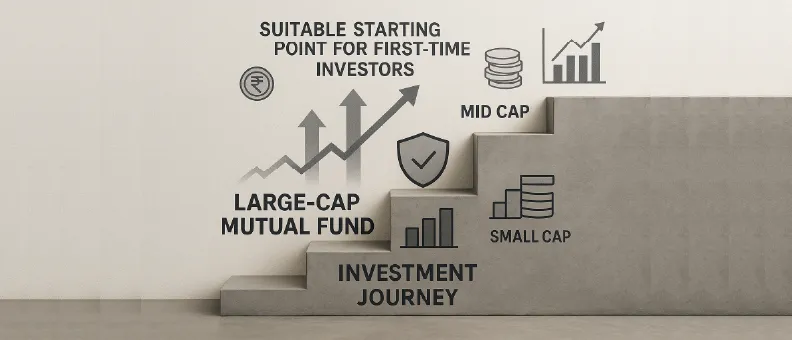Is Large and Mid Cap Funds Ideal for First-Time Investors?


Entering the world of mutual funds can feel overwhelming, especially with the wide range of schemes and jargon. If you’re a first-time investor, you’re likely seeking a fund that balances growth potential with some degree of stability. Large and mid cap funds often emerge as a suitable choice in this context. These funds uniquely blend combining India’s blue-chip giants and fast-growing mid-sized companies, offering a middle ground between relative stability and aggressive growth potential over the long term.
Let’s explore whether large and mid-cap funds are suitable for your investment debut.
- Table of contents
- What are large and mid-cap funds?
- Key features of large and mid cap funds
- Why these funds suit first-time investors
- Risk and return comparison with other fund types
- Performance trends of large and mid cap funds in India
- Things to consider before investing in large and mid-cap funds
- How to start investing in large and mid cap mutual funds
What are large and mid-cap funds?
Large and mid cap funds are equity mutual funds mandated under SEBI rules to invest at least 35% of their portfolio in large cap stocks (top 100 companies by market capitalisation) and at least 35% in mid cap stocks (companies ranked 101 to 250 by market capitalisation). The remaining allocation is flexible, allowing fund managers to optimise the portfolio for prevailing market conditions.
This structure means your money is spread across India’s most established businesses and a selection of high-potential, fast-growing companies. The dual exposure is designed to offer both relative resilience during downturns and potential to grow during bull markets.
Read Also: What are value mutual funds?
Key features of large and mid cap funds
- Balanced exposure: The fund’s portfolio is split between large caps (stable, established companies) and mid caps (growth-oriented, dynamic firms).
- Regulatory mandate: SEBI regulations ensure a minimum allocation to both segments, so you get genuine diversification.
- Professional management: Experienced fund managers actively select stocks, aiming to outperform the benchmark while mitigating risk across market cycles.
- Liquidity: These funds typically invest in stocks that are liquid, making it easy to buy or redeem units.
- Growth potential: The mid cap component can deliver potentially higher returns when markets rally (especially over a long horizon), while large caps offer relative stability and prioritise low volatility as capital compared to lower cap investments.
Read Also: Risk Tolerance: What It Is & Why It Matters for Investors
Why these funds suit first-time investors
- Built-in diversification: With exposure to both large cap and mid cap stocks, your risk is spread across different sectors and company sizes. This helps spread risk across sectors and company sizes.
- Balanced risk profile: Pure large cap funds may feel too conservative, while mid and small cap funds can be too volatile for comfort. Large and mid-cap funds sit comfortably in the middle, making them a potentially suitable option for beginners.
- Potential for returns: The large cap allocation can potentially cushion your portfolio during market corrections, while the mid cap portion can serve as a potential growth kicker during bull runs.
- Ease of understanding: The fund’s mandate is straightforward, so you know exactly where your money is going.
Risk and return comparison with other fund types
By regulation, large and mid cap funds avoid overexposure to either category, resulting in a blend of relative stability and long-term growth potential. They tend to be less risky than pure mid cap funds but offer more upside potential than pure large caps. Here’s how they compare against other equity fund categories:
- Large cap funds: These invest mainly in blue-chip companies and are known for relative stability and moderate potential returns. They are less volatile than mid- or small-cap funds but may not keep pace with strong market rallies.
- Mid cap funds: Focused on mid-sized companies, these funds can deliver potentially higher returns over a long horizon but come with higher risk and sharper swings in the short to mid term.
- Multi cap funds: These can invest across large caps, mid caps, and small caps with at least 25% allocation to each category. They may offer a higher return potential than large and mid-cap funds but also more unpredictability owing to the small cap allocation.
While all equity funds carry some level of risk, large and mid-cap funds are often considered a middle path for new investors—combining relative stability with long-term growth potential.
Performance trends of large and mid cap funds in India
Over the past several years, large and mid-cap funds have demonstrated their ability to deliver reasonable long-term returns. During market upswings, the mid cap portion often boosts overall performance, while the large cap allocation potentially helps limit losses during downturns. On a five- or ten-year horizon, many of these funds have outperformed traditional large cap funds, especially when markets have favoured mid-sized companies.
Past performance is not a guarantee of future results, and short-term fluctuations are common.
The blend of large caps and mid caps means you won’t capture the full upside potential of a mid cap rally, nor will you be fully shielded during a market correction. This balance, though, is exactly what makes these funds appealing to new investors seeking steady compounding over a long horizon with some level of risk mitigation.
Things to consider before investing in large and mid-cap funds
- Investment horizon: Equity funds, including large and mid cap funds, are suitable for a long-term horizon. This allows you to potentially ride out short-term volatility.
- Risk appetite: While these funds are less volatile than mid caps, they are still classified as ‘very high risk.’ Assess your comfort with market fluctuations.
- Fund manager track record: Look for funds managed by experienced professionals with a history of navigating various market cycles.
- Expense ratio: Lower expenses mean more of your potential returns stay with you. Compare expense ratios across funds.
- Performance consistency: Don’t be swayed by short-term outperformance. Check how the fund has performed across different market conditions.
- Exit load and taxation: Understand the exit load (if any) and the tax implications of redeeming your units.
How to start investing in large and mid cap mutual funds
- Choose a fund: Research and shortlist funds based on your goals, risk appetite, and the criteria above.
- KYC compliance: Complete your Know Your Customer (KYC) process online or at a mutual fund office.
- Select investment mode: Decide whether you want to invest a lumpsum or start a Systematic Investment Plan (SIP). SIPs are particularly beginner-friendly, allowing you to invest small amounts regularly.
- Monitor and review: Track your investment periodically but avoid reacting to every market movement. Review annually to ensure the fund still aligns with your goals and evolving financial situation.
Read Also: What are Large and Mid Cap Funds?
Conclusion
For first-time mutual fund investors, large and mid cap funds may offer a practical entry point into the world of equity investing. Their balanced approach, combining the relative stability of large caps with the long-term growth potential of mid caps, makes them less intimidating than mid or small cap funds, yet potentially more rewarding than sticking only with blue chips. While these funds are not immune to market swings, their built-in diversification and professional management can potentially help you build wealth steadily over an extended time horizon. If you’re ready to start your equity investment journey, large and mid-cap funds may deserve a spot on your shortlist.
FAQs:
Are large and mid cap funds good for beginners?
Large and mid-cap funds may be suitable for first-time investors, as they offer a balanced mix of relative stability through large-cap exposure and growth potential from mid-cap companies. This combination can help beginners gain equity exposure without the higher volatility often associated with pure mid- or small-cap funds.
What are the benefits of investing in large and mid-cap mutual funds?
Large and mid cap funds offer diversification across company sizes, combining the relative stability of large-cap stocks with the growth potential of mid-cap companies. Managed by professionals, these funds aim to provide long-term wealth creation while helping to moderate risk through balanced exposure.
How risky are large and mid-cap funds compared to other mutual funds?
Large and mid-cap funds typically carry more risk than pure large-cap funds but may be less volatile than mid- or small-cap funds. They are generally seen as a middle ground on the risk–return spectrum, balancing growth potential with some level of stability.
Can I invest in large and mid-cap funds through SIP?
Yes, you can invest in large and mid-cap funds through a Systematic Investment Plan (SIP). SIPs allow you to invest smaller amounts at regular intervals, which may help in averaging out the investment cost over time and encourage disciplined investing.
What is the difference between large cap, mid cap, and large and mid-cap funds?
Large cap funds invest primarily in big, established companies; mid cap funds focus on mid-sized, high-growth firms; large and mid-cap funds are mandated to invest in both, offering a blend of relative stability and long-term growth potential.
Mutual Fund investments are subject to market risks, read all scheme related documents carefully.
This document should not be treated as endorsement of the views/opinions or as investment advice. This document should not be construed as a research report or a recommendation to buy or sell any security. This document is for information purpose only and should not be construed as a promise on minimum returns or safeguard of capital. This document alone is not sufficient and should not be used for the development or implementation of an investment strategy. The recipient should note and understand that the information provided above may not contain all the material aspects relevant for making an investment decision. Investors are advised to consult their own investment advisor before making any investment decision in light of their risk appetite, investment goals and horizon. This information is subject to change without any prior notice.
The content herein has been prepared on the basis of publicly available information believed to be reliable. However, Bajaj Finserv Asset Management Ltd. does not guarantee the accuracy of such information, assure its completeness or warrant such information will not be changed. The tax information (if any) in this article is based on prevailing laws at the time of publishing the article and is subject to change. Please consult a tax professional or refer to the latest regulations for up-to-date information.